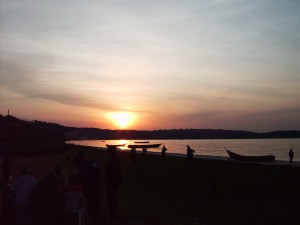
Location
Kalangala is situated in Lake Victoria/ South Western Uganda. It covers an area of 9,066.8Km2. Only 432.1Km2 (4.8%) is land and the rest is water. Total population is 34,766 (20,849 male and 13,917 female). Kalangala district is entirely made up of a total of 84 Islands widely scattered in Lake Victoria. The biggest Island is Buggala and covers an area of 296Km2. It is bordered by Mpigi district to the North, Mukono to the East, the Democratic republic of Tanzania to the South and Masaka and Rakai districts to the West.
Economic activities
The islanders depend a lot on fishing. They always migrate following the seasonal movements of fish.
Apart from tourism, the district holds several investment potentials like the BIDCO/IFAD palm oil project. IFAD has started out-growers schemes involving 35,000 farmers. Lumbering is also another economic activity.
For Livestock farming, Kalangala district is involved in production of goats, cattle, poultry (chicken) and ducks. Current estimate have the livestock population at 2,999 cattle, 250,000 poultry 1,235 goats and 7,000 pigs.
Climate and Vegetation
Kalangala experience a typical humid climate. The annual rainfall ranges from 1,125 to 2,250mm and the rainfall peaks are in March – May and October to November.
Tourism
When it comes to tranquil white sandy beaches, water wonder and natural rain forests, there is non other than Kalangala with the best. The 80 different Islands that add up the Ssese Islands grant more incredible experiences of life in Africa’s’ biggest Lake Victoria. This is a heaven in its making that offer a wonderful get away destination from the shove and flurry of the main land with in Uganda. Kalangala is composed of different Island resorts such as the Bulago Island beaches and the Chimpanzee sanctuary on Ngamba Island. Kalangala has attracted both the local and foreign tourists due to its uncountable beaches hence providing the great holiday. Besides tourism, the Ssese Islands are rich lands with fertile soils, plentiful water supply, natural tropical forests and above all jolly faces when ever you visit.
Education
The enrolment of pupils had increased to 3,867 from 2,400 in 1997 due to the introduction of the Universal Primary Education (UPE) program. Nevertheless this is still low because from the study of the population structures in Kalangala, it has been noted that only 38% go to school. This means that 62% of the school going age children can not access the primary education.
Some of the factors accredited to this phenomenon include; the less number of schools available in the district, lack of standard water transport to travel to the Islands with the schools because out of the 64 occupied islands, only 6 have schools, the migratory tendencies of most fishing communities who seek for better fishing grounds is another factor that have contributed to the low attendances in schools. Etc
Infrastructure
Kalangala district is connected to the main land by ferry and several boats. The main means of transport linking the Ssese Islands with in and to the main land is water transport. Recently the district obtained a new bigger ferry from the government to improve transport to and from Kalangala district.
Communication
The district is served by all the mobile telecommunication networks in Uganda. That is Uganda Telecom, MTN and Celtel Uganda. A first radio station in the district is near completion. This will simplify the broadcasting of information with in the district once it is completed. The mean annual temperatures vary from 250C to 27.50C with minimums of 17 – 180C. The district receives plentiful sunshine with up to 7.3 hours of sunshine per day.
Health
The district is divided into two sub health districts whose centres of operation are the health centre (HC) IVs. These are headed by a medical officer. Kalangala is served by 12 health units;
Two (2) HC IVs, Six (6) HC IIIs and four (4) HC IIs, one (1) HC – Bumangi is operated by an NGO; The Roman Catholic Church. All the HC IVs have a maternity ward, general ward, laboratory and store. The HC IIIs have an Out Patient Department, maternity ward and staff houses.
There are a total of 20 hospital beds in the district and only one Voluntary Counseling and Testing – VCT centre.
Public health in the district is still very poor. Latrine coverage stands at only 45%, this means that very many of the people use the bushes. This has led to many infections such as diarrhea and unclean water. People are cramped up in the already congested landing sites without pit latrines such sites include Busindi in Mazinga and Lwamba in Bukasa.
The health situation in the district is that;
There are no functional theatres at the HC IVs and most health centres do not have adequate space, equipment and staff for the effective delivery of health services.
All the health centres have not yet been upgraded to acquire the minimum approved building structures to address the problem of working space.
Five (5) parishes do not have infrastructure for health facilities.
The district faces staffing problems. There are a few trained staff. The knowledge and skill for some of the staff is inadequate to provide a minimum health package to the population. For the few staff better accommodation needs to be provided especially in the peripheral areas such as on Mazinga Island.
The HIV/Aids rate in the district has not yet been discovered but it is broadly alleged that the infection rate is rising. At Kalangala HC IV; the only centre with VCT facility, the rate stands at 34% a lot higher than the national rate of 6.1%. Districts’ efforts in the fight against HIV/AIDS prevalence include community sensitization.
A local quality assessment survey in the district indicated that most of the participants about 72.6% men, 53% women and 61% youths had knowledge of at least two ways on prevention of HIV/AIDS. But, the problem is that very few of the interviewed actually used condoms regularly. Only 51.6% men, 205 women and 20.6% youths regularly used the condoms with their partners.
Prostitution, rape, high mobility of people, drug and substance abuse and myths and misconceptions about condom use rage high among the population. And also, there are fewer women; many AIDS widows, high promiscuity rates and the inability of the women to negotiate safe sex with partners have led to the increase in the infection rate in Kalangala.

 Posted in
Posted in 

